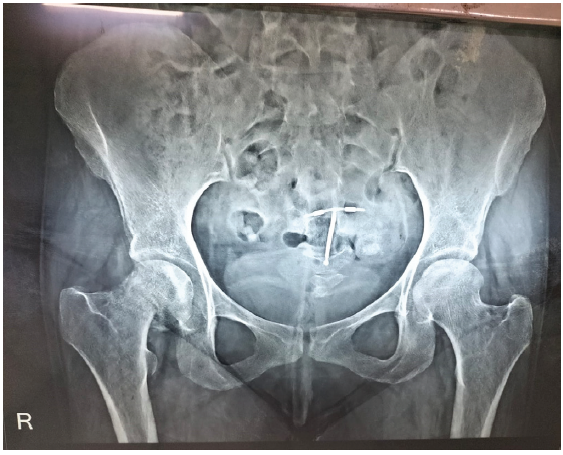Translate this page into:
Tenofovir-Induced Fanconi Syndrome Associated with a Fragility Fracture of the Right Femoral Neck
Corresponding author: Lakhan Singh, Department of Endocrinology, Lala Lajpat Rai Memorial Medical College, Meerut, Uttar Pradesh, India. E-mail: lakhanmahalawat@gmail.com
-
Received: ,
Accepted: ,
How to cite this article: Singh L, Bharadwaj S, Singh G, Gupta I. Tenofovir-Induced Fanconi Syndrome Associated with a Fragility Fracture of the Right Femoral Neck. Indian J Nephrol. 2025;35:311-2. doi: 10.25259/IJN_454_2024
Dear Editor,
Fanconi syndrome is a metabolic defect in renal transport caused by proximal tubular cell dysfunction. It impairs the reabsorption of water, glucose, phosphate, potassium, amino acids, and other substances.1 We present a case of renal dysfunction and osteoporosis associated with tenofovir use.
A 36-year-old female, a known case of HIV-1 since 2005, presented with complaints of proximal muscle weakness, muscle pain, and pain in the right hip joint for the past two months, with history of slipping on the floor four months ago. She had been taking a combination of tenofovir, lamivudine, ritonavir, and atazanavir for the past two years. She was diagnosed with a malunited fracture of the right femoral neck [Figure 1]. She underwent evaluation for osteoporosis. Her hemoglobin was 9.0 g/dL, vitamin B12 912 pg/mL, urea 48 mg/dL, creatinine 4.16 mg/dL, alkaline phosphatase 1220 U/L, serum sodium 142 mEq/L, potassium 3.6 mEq/L, calcium 8.5 mg/dL, albumin 3.85 g/dL, phosphorus 2.2 mg/dL, vitamin D 122.8 ng/mL, serum bicarbonate 11.0 mEq/L, thyroid-stimulating hormone 1.9 µIU/mL, and urine albumin-to-creatinine ratio 283.6 mg/g. Her urine examination showed glycosuria and proteinuria. The tubular maximum phosphate reabsorption was 2.0 mg/dL, suggesting phosphaturia [Supplementary Table 1]. Ultrasonography was suggestive of bilateral small kidneys with medical renal disease. Dual-energy X-ray absorptiometry scan showed a Z-score of ‒3 at the left hip joint, indicating osteoporosis. The patient was diagnosed with Fanconi syndrome with right femoral neck fracture with osteoporosis. Tenofovir was discontinued, and she was started on sodium bicarbonate, telmisartan, calcium, iron, potassium citrate syrup, phosphorus, and injection denosumab 60 mg subcutaneously. Over the six-month follow-up period, the patient had marked symptomatic improvement and her renal function improved.

- X ray imaging of the pelvis with bilateral hip joint showing fracture in the right neck of the femur.
Tenofovir can lead to acute kidney injury, chronic kidney disease, proximal tubular cell damage, and Fanconi syndrome as well as bone problems like osteopenia and osteoporosis. Therefore, patients on long-term tenofovir should undergo close monitoring of renal parameters and bone mineral density markers to prevent nephrotoxicity and adverse bone effects.2
Conflicts of interest
There are no conflicts of interest.
References
- Clinical manifestations and diagnosis of Fanconi syndrome. J Nephrology. 2021;34:345-54.
- [Google Scholar]
- Renal safety of tenofovir alafenamide vs tenofovir disoproxil fumarate. The Lancet HIV. 2017;4:e314-23.
- [Google Scholar]






